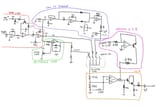>>2943921
>>2943912
>>2943909
You are diving in a lot deeper than I expected, and now I'm self conscious about my lack of knowledge and planning kek
First off I'm pretty sure 500 kHz is the actual frequency of the PWM signal, not the clock speed, but it can go as high as the clock speed of the Pi Pico I'm using.
>does anon really want to replicated the Juno design except with the amplitude control set by a PWM DAC?
Basically yes, I want to use the Pico to run my analog "ramp core", and then derive other waveforms from that via traditional methods with op amps. I already have this set up and working for triangle and variable width square (that's what you can see in the webm of my original post)
The output voltages are going to one of two places - either as the input to the integrator circuit from the article you found (sawtooth generator), or a control voltage to a voltage controlled amplifier (LM13700 IC). All voltages buffered with TL074 op amps.
But I need up to 8 simultaneous tones - so 8 integrator signals, and 8 envelopes to 8 VCA's. I think it would be beyond the Pico's capabilities to generate 8 waveforms simultaneously in software and output them via PWM, plus I want to do it the analog way with the clocked integrator circuit.
Given that the integrator input only determines the loudness of the sawtooth wave, I can afford to be a bit imprecise and maybe smoothed PWM will be sufficient. But for the envelopes controlling the VCAs, I need up to 8 accurate ADSR envelopes, and that's where I think DACs may be better (but they may just be overkill).
Here's my awful circuit diagram of the analog parts if it's any use.
4chan Search
1 results for "1ab7d3d13acadaa4d660a156b8b87ca3"
